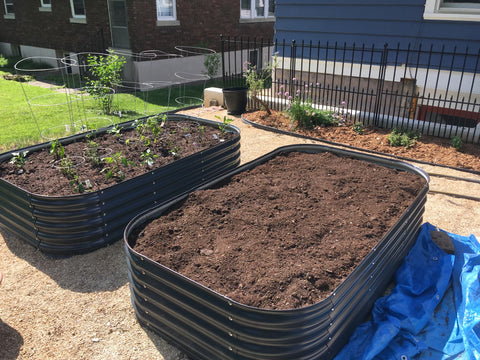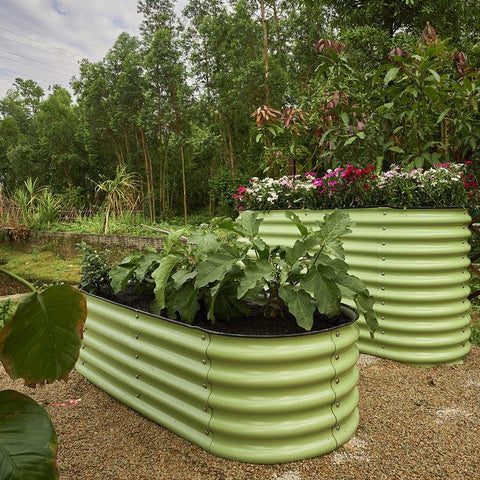15 Free Tips from Olle Garden Bed: for Improving Garden Soil
Rich and high-quality planting media can make gardening simple, efficient and interesting. These free soil improvement techniques will teach you how to achieve this goal without spending too much money on fertilizer and soil conditioner. Use these guidelines from Olle Garden Beds to find the best ways for your needs.
Check soil condition
Before you consider improving your soil, test what it has. In most cases, basic tests check phosphorus, nitrogen, potassium and ph values. Fortunately, there are some convenient and cheap methods on the market that you can try at home. You can also contact your local office or soil laboratory for detailed results. The most basic test anyone can do to understand the texture is the squeeze test. To do this, take a handful of damp garden soil and squeeze it into a ball, then open your hand. If it stays in shape until you poke it gently, it means it's loam, which is great!

- Check and control soil ph value
The ph of the soil tells you how alkaline, acidic, or neutral the garden soil is. Different plants need different ph values to give full play to their potential. For example, the best range for potatoes is 6 to 6.5, while the ideal ph for lavender is 6.5 to 8.
What if the soil is too acidic?
Too acidic soil means a ph below 7. If you need to increase the ph value, you can use any product containing lime to strengthen the soil to meet the growth requirements.
Mix a tablespoon of baking soda with a gallon of water and use it to naturally reduce the acidity of the soil.
What if the soil is too alkaline?
When the ph value is higher than 7, there is too much alkaline soil. Add sphagnum to the soil to modify it as a plant that likes acidic soil. Add 2-4 inches to the top of the soil and mix well.
You can also mix half a cup of vinegar in a gallon of water into the soil, which can help you lower the ph of the soil and naturally increase its acidity level.
- Check soil temperature before planting
Knowing soil temperature before planting is essential to prevent disease or growth problems. Although the air may feel warm to you, the soil may still be cold. You can use an ordinary thermometer that can read the temperature immediately.
In addition to the two, you can also execute:
Earthworm test: dig out the soil and look for earthworms. If you find 4-10 of them, the growth medium is very healthy.
- Aged feces
Microbial activity in the growth medium is critical for obtaining, cycling and releasing nutrients, ensuring that plants receive the correct amounts of carbon, nitrogen and phosphorus.
Adding feces to the soil is the best way to increase microbial biomass, while providing organic carbon and nutrients, which significantly helps stimulate microbial activity, so as to better grow and diversify microorganisms in the soil.
The feces of farm animals such as goats, cows, alpacas, sheep, rabbits, chickens and horses are the best way to improve the soil. Add it to the garden bed at least once during the growing season to strengthen the soil and provide nutrients stably.
- Green manure
Green manure plants can be planted as living mulch in the yard, because they form compact mats by adding each other, so that plants can be protected from soil splash and erosion.
You can also choose green leaf fertilization, which is a term used for the process of using the leaves and branches of trees and other plants. It contributes to the reclamation of alkaline soil and controls the growth of root knot nematodes.
Wild peas and peas are some of the great green manure plants. You can also plant annual ryegrass, oats, rapeseed, winter wheat, winter rye and other grasses.
Nitrogen fixation of beans is a partnership between bacteria and plants. In beans, bacteria live in small growths at the root, called nodules. In these nodules, nitrogen fixation is completed, and the upcoming plants absorb the NH3 produced. You can also choose to plant nitrogen fixing plants, such as peanuts, cowpeas, soybeans and broad beans.
- Used hay or straw
Straw is a by-product of dry straw from cereal plants such as barley, rice, oats and rye. On the other hand, hay is a kind of hay, including seed heads, leaves and stems.
They are the best choice for topdressing growth medium, because they make the soil rich in organic matter. This also helps to control weeds, and because of its rapid decomposition, this allows plants to obtain a stable supply of nutrients.
Using this mulch also helps the soil isolate the soil and capture water in summer, which is really helpful if you live in a warm climate.
Straw and hay are very suitable for creating microclimate, because they can be made into organic blankets to protect it from the sun and wind.

- Chopped grass
Don't waste the grass cut on the lawn, because it is rich in minerals and provides food for beneficial microorganisms and earthworms. Leaves help break down heavier clays and retain moisture in lighter loamy soils.
Chopped grass is also an important source of carbon, which can provide solid power for your composting for free.
- Wood chips
You can also use wood chips as a cover for your garden bed. You can also mix it in the growth medium to increase the porosity and water retention capacity of the soil. You can find wood chips for free through tree services or green recycling facilities in your area.
- Kitchen residue
The kitchen may be a gold mine, because banana peel, eggshell, tea, vegetables and other fruit residues can add nutrients to your soil for free.
You can also throw some banana or pomegranate residues into the planting hole when planting, or sprinkle some of them on the soil of the garden to let them decompose naturally.
- Coffee grounds
When you mix the used coffee grounds into the soil or compost them, it will improve the soil structure and help drive away some insects. The nitrogen content of the ground is already very high, which is very suitable for the plants fed in large quantities in the garden.
You can add coffee grounds to leaf mold to make an excellent nutritional cover for your garden, which is completely free.
- Wood ash
Wood ash contains sufficient calcium, potassium and many micronutrients of wood derived trees.
Wood ash helps raise the ph of garden soil and makes it more alkaline. Therefore, you must not use it on plants that like acid very much, such as blueberries or azaleas. This magical powder can also protect plants from slugs, snails, aphids and mealybugs.

- Worm casting
Worm casting or earthworm dung is an extract left from worms. It contains all three important plant elements - nitrogen, phosphorus and potassium, and has a neutral ph value. It can improve soil texture and enrich it.
- Leaf mold
Leaf mold, also known as black gold, is a compost leaf. However, it has experienced a slow process, but it is really worth the process, because it is an excellent soil additive. All you have to do is collect all the leaves in the garden and wet them. Continue to add leaves, which will be ready for use in 1-2 years. Here is a tutorial video for help.
After making, mix it thoroughly in your soil!
- Cover soil in winter
Cover garden soil in winter or before rain to prevent it from becoming compact and excessively wet. To do this, you can use old clothes or plastic wrap. If you have an open compost heap, don't forget to also cover it. This will save you time in the next growing season, and you won't have to break the soil.
- Sun the soil
Sunlit soil refers to preparing the garden bed to plant the plants of your choice by removing all weeds and other unwanted plants.
This includes mowing the ground, watering it, and covering the area with plastic sheeting. Weeds will grow, but the heat captured by plastic will destroy them in 6-8 weeks.
- Urine
It sounds interesting or strange, but human urine is sterile and one of the best sources of soil improvement and fertilization. Human urine is rich in nitrogen, potassium, phosphorus and other micronutrients.
It is best to avoid adding urine directly to plants, as it may be too concentrated for them. Dilute with equal amount of water and use in the growth medium.
